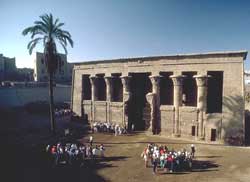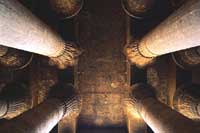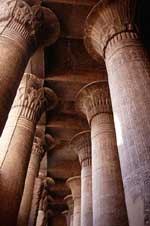|
The Temple of Esna
 The temple, which lies in a pit below the level of the houses in
Isna, is dedicated to the god, Khnum. This the ram god that was
worshipped through out this area and who fashioned mankind from
mud of the Nile on his potter's wheel. The temple, which lies in a pit below the level of the houses in
Isna, is dedicated to the god, Khnum. This the ram god that was
worshipped through out this area and who fashioned mankind from
mud of the Nile on his potter's wheel.
He was associated with other gods, including Menhyt (his
consort), Nebtu (the goddess of the countryside) and Hka (the
manifestation of vital energy).
While all that remains of the temple is the Great Hypostyle
Hall, surrounding ruins of the ancient complex and city have yet
to be excavated due to the modern housing built on the site. The
temple sits atop the ruins of earlier temple(s).
 Ptolemy VI originally began this building project, but the
Temple of Khnum was a later addition built by the Roman emperor
Claudius in the 1st century. Ptolemy VI originally began this building project, but the
Temple of Khnum was a later addition built by the Roman emperor
Claudius in the 1st century.
The rectangular hall opens to the west.
The roof is still intact, supported by 24 columns decorated with
a series of text recording hymns to Khnum and relating the
annual sacred festivals of Esna with scenes illustrating the
surrounding countryside.
 The sacred festivals are the creation of the universe by Neith,
the raising of the sky by Khnum, and his victory over the human
rebels. The sacred festivals are the creation of the universe by Neith,
the raising of the sky by Khnum, and his victory over the human
rebels.
These texts were done between the Graeco-Roman period and the
rule of Decius in 250 AD, but were never finished.
There are 16 different palm and plant capitals on the columns,
still with some good color.
The west wall of the Temple of Khnum is all that remains of the
original Ptolemaic temple and has reliefs of Ptolemy VI and
Philometor and Euergetes II.
In the forecourt of the temple are blocks from an early
Christian church. Then also is an inscription found on the back
of a block from Emperor Decius decreeing that Christians will
suffer death if they do not sacrifice to the pagan gods. |